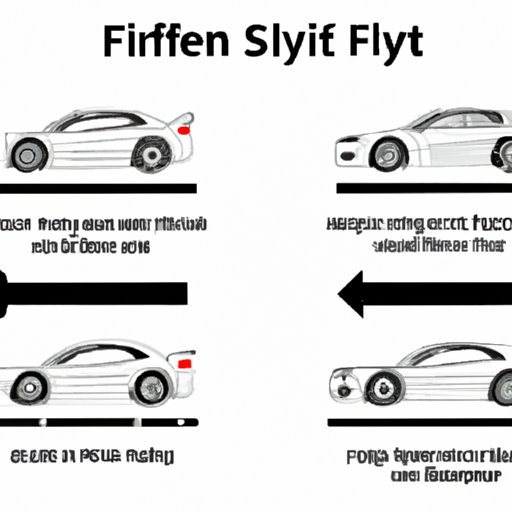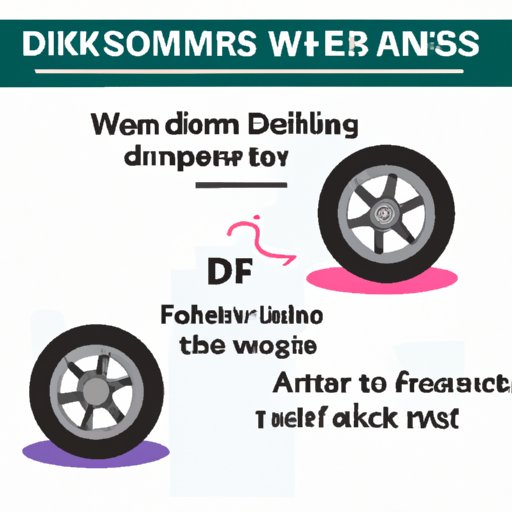
I. Introduction
If you’re an enthusiast of the sport of drifting, you know that drifting with a front wheel drive (FWD) car is not as common as drifting with a rear wheel drive (RWD) car. In this article, we will explore the question of whether or not you can drift with FWD. We’ll provide you with top tips for drifting with an FWD car, the pros and cons of using FWD cars for drifting, modifications you can make to transform your FWD car into a drift machine, how drifting with an FWD car compares to RWD car drifting, common mistakes FWD drifters make, and a list of famous FWD drifters for inspiration.
II. Top Tips for Drifting a Front Wheel Drive Car
If you’re ready to try drifting with an FWD car, here are some tips you should follow:
A. Weight Transfer Techniques
One of the most important techniques in drifting is weight transfer. With FWD cars, you should focus on shifting the weight of the car to the rear wheels. This can be achieved by lifting off the throttle suddenly while turning into the drift to cause weight transfer to the rear and then onto the front to maintain the drift.
B. Power Transfer Techniques
The throttle is not just for going fast in drifting; precise throttle control is important for keeping the car in a drift. In FWD cars, it’s important to use the throttle as you go into a drift and then let off to keep the car in balance. Over-application of throttle can lead to spins, so be cautious with how much you use it.
C. Advantages of Modding the Car
FWD cars can drift, but modifying your car can make drifting a lot easier. Some essential modifications include suspension upgrades, such as lowering springs or coilovers, upgraded sway bars to reduce body roll, and upgraded brakes to help stop the car after a drift.
D. Safety Tips to Keep in Mind
First and foremost, always wear a helmet when driving. Additionally, always drift in a safe and controlled environment, such as on a private track or in a drift competition. It’s also important to remember that drifting puts a lot of stress on the car, so regular maintenance is important to ensure that your car is in top condition.
III. The Pros and Cons of Drifting with a Front Wheel Drive Car
A. Advantages of Using FWD Cars for Drifting
Compared to RWD cars, FWD cars tend to be less expensive, more readily available, and more fuel-efficient. Plus, they can be easier to handle, especially for beginning drifters. Additionally, FWD cars tend to have more traction due to the weight of the engine sitting over the drive wheels, making them easier to control in certain situations.
B. Disadvantages of Using FWD Cars for Drifting
The main disadvantage of using FWD cars for drifting is that they tend to understeer. This means that they are far more likely to grip and straighten up in turns, which makes them less ideal for the sport of drifting.
C. Comparison with Other Types of Cars
While FWD cars have certain advantages and disadvantages, their unique characteristics make them a fun and challenging option for drifters. Ultimately, the type of car you choose comes down to your personal preference and driving style.
IV. How to Modify Your Front Wheel Drive Car for Drifting
A. Suspension Upgrades and Adjustments
The suspension is a critical element in creating a drift-ready car. To get the correct balance between stability and control, you can adjust your car’s suspension by adding coilovers or lowering springs. Upgrading sway bars can also help reduce body roll, which can make it easier to control your car during a drift.
B. Engine Modifications and Upgrades
The engine is the heart of any drift car. Upgrading your engine can help increase the power of your car, which is necessary for initiating and maintaining a drift. Popular engine upgrades include turbo kits, intake and exhaust systems, and upgrading the engine management system.
C. Tires and Wheels Upgrades
Different tires and wheels can significantly impact the performance of your drift car. It’s important to choose tires with a soft compound and high grip in order to achieve maximum control during a drift. Upgrading to lightweight wheels can also help to improve acceleration and braking time.
D. Other Modifications That Can Be Made
Additional modifications can include installing a limited-slip differential, replacing the clutch with a performance version, installing a roll cage, and upgrading the brakes.
V. Drifting with Front Wheel Drive vs. Rear Wheel Drive
A. Key Similarities and Differences
While there are some key differences between FWD and RWD cars, there are also some similarities. Both require weight transfer and precise throttle control to initiate and maintain a drift. However, with RWD cars, the movement of the car comes from the rear, whereas with FWD cars, the movement comes from the front.
B. Pros and Cons of Each Method
RWD cars tend to be the preferred method of drifting due to their tendency to oversteer rather than understeer, which means it’s easier to initiate a drift with them. However, they can also be more expensive and harder to find. FWD cars, on the other hand, tend to be more affordable and readily available, but they require more skill to drift with them due to their inherent understeer.
C. Comparison of Driving Techniques
Driving techniques between the two types of cars can differ significantly. FWD cars require a more subtle and gentle touch on the throttle, whereas RWD cars can handle more aggressive driving styles.

VI. Common Mistakes Front Wheel Drive Drifters Make
A. Oversteering
One common mistake that FWD drifters make is oversteering, which occurs when the steering wheel is turned too much and the car loses balance.
B. Using Too Much Throttle
Another mistake is using too much throttle, which can cause the car to spin out of control. It’s important to use the throttle cautiously and precisely to maintain balance.
C. Lacking Consistency
Drifting requires a lot of practice, and many FWD drifters struggle with being consistent with their movements and weight transfer. Consistency is key to mastering the art of drifting with an FWD car.
D. Other Common Mistakes and How to Avoid Them
Other common mistakes include not properly modding the car or skimping on maintenance. It’s crucial to regularly maintain your car and ensure that it’s up to par for drifting.
VII. Famous Front Wheel Drive Drifters
A. Overview of Some of the Most Famous FWD Drifters
While not as common as RWD drifters, there are some notable FWD drifters who have made a name for themselves in the sport. Ken Block, the founder of Hoonigan Racing Division, is known for his impressive FWD drifting skills. Dai Yoshihara and Kris Hampton are also notable figures in the FWD drifting community.
B. Their Backgrounds and Achievements
Ken Block is a professional rally driver and stunt driver who has competed in numerous rally and rallycross events. Dai Yoshihara is a Japanese-American drift driver who has won multiple championships in various drifting competitions. Kris Hampton is also a professional drift driver who has competed in Formula Drift competitions.
C. Their Driving Styles and Techniques
Each of these drivers has a unique driving style and technique that sets them apart from other FWD drifters. Ken Block is known for his precision driving and his ability to control the car while drifting through narrow spaces. Dai Yoshihara is a master of weight transfer and throttle control, and Kris Hampton is known for his smooth yet explosive driving style.
VIII. Conclusion
While FWD cars are not as commonly used in drifting as RWD cars, they can still be a fun and challenging way to experience the sport. The key to drifting with an FWD car is to focus on weight transfer and precise throttle control, as well as making essential modifications to your car. While there are certainly challenges to drifting with an FWD car, with practice and dedication, it can be just as rewarding as drifting with a RWD car.




